Key Takeaways
- Emerald carries a strong sense of vibrancy, sincerity, and creativity that appeals to many individuals who enjoy its refreshing tone.
- Its color symbolism often points toward growth, renewal, and soothing energy, yet it also exudes confidence and sophistication in design contexts.
- In color psychology, Emerald can influence mood by promoting a calm yet motivated mindset.
- This hue integrates well with both warm color symbolism and cool color symbolism, making it versatile for home décor, branding, and everyday style choices.
- Its universal color meanings connect with themes of balance and optimism, tapping into shared human experiences and emotional responses.
Introduction

Emerald often sparks admiration the moment someone sees it, thanks to its lush tone that feels both comforting and bold.
People link it to resilience, warmth, reliability, elegance, creativity, depth, passion, calmness, optimism, mystery, innovation, energy, clarity, balance, charm, allure, authenticity, confidence, wisdom, spontaneity, tranquility, and dynamism. These traits come together in a color that appears soothing, yet still stands out.
Why do so many individuals feel drawn to this intense shade of green? Some connect it with springtime freshness, others see it as a symbol of strength.
Many regard Emerald as a color that represents emotional balance and renewal. It has a history of being prized in jewelry, art, interior design, and brand marketing. Its emotional impact can shift based on culture, personal preference, or even a room’s lighting.
Throughout this article, we will explore color meanings tied to Emerald from many angles. We will focus on color symbolism, color psychology, color connotations, and color associations, while uncovering less-common insights into how Emerald can stir deeper feelings or shape design choices. We will also share practical tips and suggestions for anyone eager to harness Emerald’s magic in a wardrobe, a living space, or a marketing campaign.
In the sections that follow, you will find 14 key topics. Each offers three subsections full of design color meanings, psychological effects of color, and cultural color meanings. You will see references to scientific studies on color when relevant and find easy-to-follow ideas that you can use right away. Let’s begin this journey into a color that has fascinated humans for centuries.
The Allure of Emerald

Vibrant Symbolism
Emerald attracts attention through its vibrant yet grounded presence. Many color interpretations link this shade to renewal and perseverance. In some traditions, Emerald stands for clear thinking. This idea stems from how green often hints at health or growth. Emerald appears warmer than other greens, thanks to its radiant undertones.
When people speak about emerald’s personality, they mention how it balances vibrancy with a subtle warmth. This balance creates an impression of calm strength. It keeps people feeling steady rather than agitated. Some might sense a refreshing spark, while others detect a comforting stillness. Either way, the color is hard to ignore.
A Glimpse into Culture
Cultural color symbolism often shapes how we interpret Emerald. Ancient communities sometimes viewed it as a lucky stone. They felt it could usher in abundance. In certain parts of the world, green is tied to fertility, so Emerald found its place in celebrations that honored growth or new beginnings.
Around various regions, you might see Emerald featured in fabrics or decorations during special gatherings. Even in modern times, brands use Emerald to project a message of nature and progress. Different cultures have their own spin on it, but the underlying theme of renewal remains constant.
Timeless Emotion
Emerald sparks emotions that feel timeless: optimism, curiosity, and peace. It often boosts an interior space by adding a layer of welcoming energy. While some associate it with nature’s calm embrace, others enjoy its ability to energize conversations or gatherings.
People sometimes keep small items in Emerald hues on their desk, hoping it will bring more clarity to their thoughts. They may also choose Emerald accents at home to create a soothing vibe. This color’s emotional impact ranges from tranquil to mildly invigorating. That balance is what keeps Emerald relevant in style and design movements, year after year.
Emerald in Design
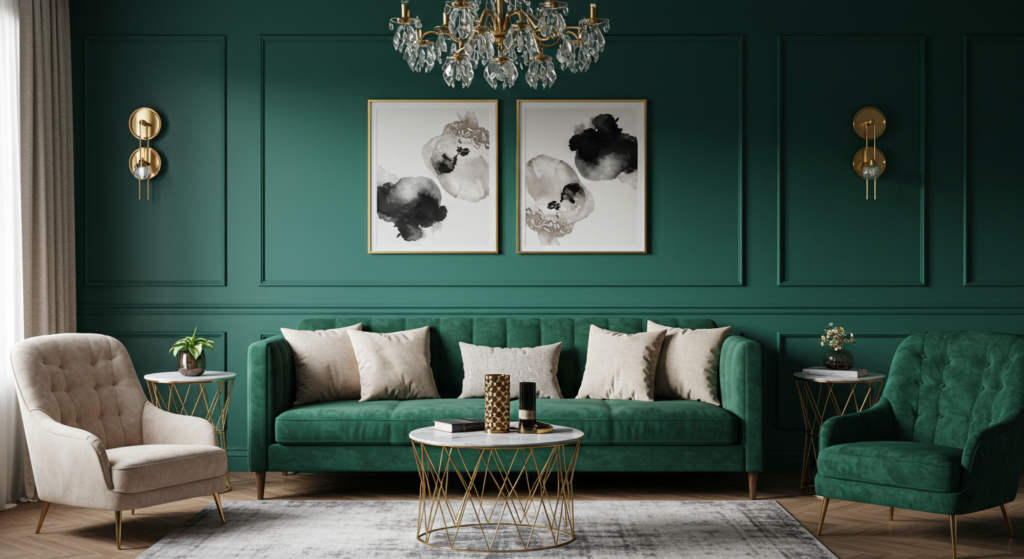
Interiors that Spark Inspiration
In interior design color meanings, Emerald works well for those who want a dash of boldness without overwhelming a space. It can appear in accent walls, decorative pillows, or curated art pieces. The color can shift an entire room’s mood by offering a refined kind of cheer. It pairs neatly with neutrals such as cream or beige, allowing Emerald’s energy to shine.
Emerald also plays nicely with metallic accents like gold or bronze. These pairings create a look that feels chic but not too flashy. In a bright room, Emerald walls or furnishings may evoke a sense of natural harmony. In a dimmer space, they can supply a moody yet calm ambiance. This adaptability is one reason color branding experts sometimes suggest Emerald for hospitality venues that want a peaceful but rich atmosphere.
Fashion Accents with Impact
When it comes to wardrobes, Emerald’s vibrant personality can add an interesting twist. A simple accessory like a scarf or a belt in Emerald can bring a new spark to an otherwise neutral outfit. Some prefer an Emerald dress for formal gatherings, since it suggests both confidence and elegance.
Beyond clothing, many enjoy Emerald jewelry. It has the ability to stand out against skin tones with a luminous quality. It can look regal, especially when set in gold or rose gold. On the other hand, if someone wants a more casual vibe, an Emerald statement piece can still elevate everyday jeans and a T-shirt by creating a focus point. This approach invites warmth without too much loudness.
Branding with Depth
Marketing teams often search for colors that speak to their brand identity. Emerald can offer a sense of trust, reliability, and forward-thinking. It is also associated with nature-inspired themes, appealing to environmentally-minded consumers. Companies that want to appear strong yet approachable sometimes adopt an Emerald-based palette.
Logos that feature Emerald might suggest longevity and a nod to growth. That makes sense for eco-friendly products or organizations highlighting wellness. In color marketing, Emerald has a way of standing out in social media feeds crowded with blues and reds. Its lively essence can make an instant impression, especially if paired with a crisp white background or subtle gold text.
Historical Significance

Ancient Beliefs
Emerald has a long record of admiration. Many cultures prized it for spiritual reasons. Some believed it held protective powers. Ancient royals often wore Emerald ornaments to showcase status and to attract good fortune. Although these beliefs vary across regions, the thread of respect for this vibrant hue remains steady.
Some old documents reference Emerald as a symbol of wisdom. This ties in with how many early societies linked green with fertility and knowledge. While evidence of these stories can be hard to confirm, they continue to color our perception of Emerald. It endures as a hue that carries a sense of old-world mystique and enchantment.
Modern Adaptations
Emerald remains popular today. Designers, jewelers, and artists pull inspiration from centuries of lore while adding modern twists. It is often a top pick for everything from gem-studded phone cases to stylish sneakers. Some interior designers favor it for accent pieces, believing it brings a comforting link to nature.
Movies and television sometimes feature Emerald to suggest wealth, magic, or adventure. That visual language can shape how the general public responds to this color. Even if one doesn’t buy into the ancient symbolism, glimpses of Emerald in popular culture keep its fascinating aura alive.
Cultural Ceremonies
In many parts of the globe, green shades, including Emerald, appear in ceremonial events. These might be weddings, births, or milestones. Ceremonial garments in this hue sometimes convey blessings or hope. For some gatherings, Emerald decorations signify unity with nature, especially if an event is tied to planting or harvest festivities.
Emerald stones are also gifted to mark special anniversaries. Some choose them to represent a renewed vow or promise. The stone’s classic charm suits many kinds of celebrations. While not every culture uses Emerald in the same way, the shared appreciation for its uplifting energy seems universal.
Emotional Color Meanings
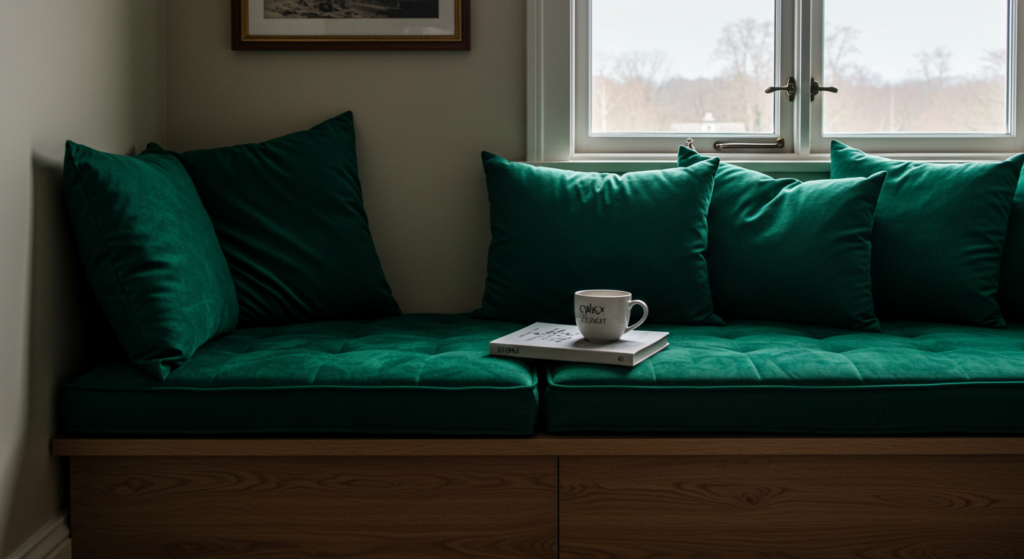
Understated Confidence
Emerald’s emotional resonance often suggests quiet confidence. Unlike brighter greens that can look too sharp, Emerald carries a balanced tone. It hints at composure and self-assuredness without feeling arrogant. This impression can come through in a well-chosen accent piece or a brand’s logo.
For instance, a corporate team might choose Emerald ties or pocket squares for an event to project unity and composure. In a more casual context, an Emerald sweater can give the wearer a sense of calm empowerment. It stands out but stays elegant at the same time.
Calming Yet Powerful
Green, in general, has a reputation for relaxation. Emerald, however, mixes that serenity with a jolt of lively energy. That combination can guide people toward a steadier emotional state. This color is often featured in waiting rooms or therapy spaces because it provides a subtle reminder of nature’s calming presence.
People who seek relaxation may find Emerald a suitable choice for bedroom décor. Curtains or sheets in this hue can make the space feel like a restful haven. Others might keep an Emerald tapestry on the wall to maintain a calm mood. Even if an individual doesn’t consciously notice it, the color can soothe frayed nerves.
Impact on Mood
Emerald, when used sparingly, can sharpen focus. In a busy workspace, a small Emerald item might encourage clear thinking. This effect can help spark creativity. Some psychological color analysis theories suggest certain greens assist with mental clarity. Emerald fits that category by offering more depth than light pastel greens.
If a person feels stressed, a glance at something in Emerald might redirect the mind to simpler moments outdoors, possibly lifting mood. This color’s balance between warmth and freshness sets it apart from many other greens. That subtle difference could be why it resonates with so many people worldwide.
Scientific Studies on Color

Eye Response to Green
Researchers have tested how eyes respond to various hues, and green often ranks as easy to perceive. Emerald, as a deeper shade, can appear comfortable for the eyes in certain lighting. Some studies note that mid-range greens help reduce strain. This might be why many user-interface designs use green elements for notifications that affirm success or positive actions.
Though these findings vary, there is a consistent thread: green can be gentler to process than some intense reds or yellows. Emerald’s moderate intensity still offers contrast without jarring the viewer. This phenomenon aids people who enjoy using Emerald backgrounds for digital screens.
Neuroscience of Comfort
Some color psychology research touches on how hues can affect neural pathways linked to relaxation. Emerald’s connection to nature, growth, and renewal can signal the brain to enter a calmer state. While the exact mechanisms require further exploration, anecdotal evidence supports the idea that green hues foster composure.
Colors influence many subtle processes in the mind. People who prefer green often say it helps them think more positively. When tested, they might feel less anxious in a green environment. Emerald’s deeper tone can add a layer of quiet sophistication to these soothing traits. It is not too bright, and that can support gentle concentration.
Possible Visual Benefits
Some eye-care professionals suggest short breaks that involve looking at greenery to reduce screen fatigue. Emerald objects on a desk or wall might serve a similar purpose. When the eye shifts focus to a calming color, tension can ease. Small details like an Emerald mouse pad or pen holder might gradually contribute to a more relaxed workspace.
Though these suggestions are not a cure-all, they might complement other healthy habits. Taking a step outside to observe real nature is often the best option. If that isn’t possible, glancing at an Emerald-hued poster or keeping a desk plant in a pot painted Emerald could add a slight benefit.
Symbolic Colors in Nature

Emerald Scenery
Nature uses green in many mesmerizing ways, from rolling hills to sun-dappled forests. Emerald tones stand out when sunlight filters through thick leaves or mossy rocks near a waterfall. This color appears in water at certain depths as well, reflecting life beneath the surface.
Nature’s color meanings for green often revolve around growth and renewal. Emerald’s extra depth creates a sense of mystery. If you have seen photos of dense tropical jungles, you might recall the rich glow of green under a canopy of trees. That lushness can translate into design choices at home or in marketing materials, capturing a tiny piece of the natural environment.
Animal Markings
In the animal kingdom, Emerald can serve as camouflage or a display of brilliance. Certain birds flaunt Emerald feathers to attract mates or stand out among their flock. Reptiles and amphibians sometimes sport an Emerald sheen as a defense, blending with foliage.
These creatures remind us that color is not just about looks. It can carry meaning for survival or attraction. When used in design or art, Emerald might suggest both subtle stealth and flamboyance. It depends on context. This duality makes Emerald a fun hue to explore for those aiming to convey multiple ideas at once.
Plant Kingdom Impressions
The plant world holds many examples of Emerald leaves, stems, and petals. Some ornamental plants have a distinctive Emerald shade that signals vitality. This color can hint at robust growth and health. Gardeners often mention the moment they see that rich, healthy green sprout. It shows that a plant is well on its way to blooming.
For interior design color meanings, bringing in potted plants with Emerald foliage can reinforce a sense of fresh air. This approach ties together nature’s color associations with a living piece of décor. People might feel more at ease in a space that includes these vibrant details.
Psychological Effects of Emerald
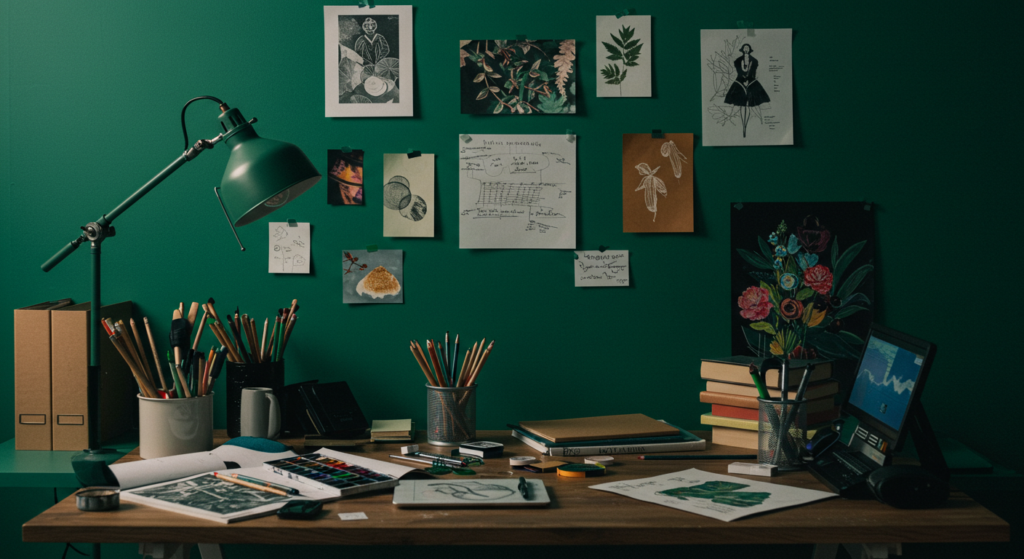
Focus and Reflection
Emerald’s shade often supports mental focus. It balances an organic feel with a slight hint of energy. That makes it appealing for reading nooks or study corners. When placed next to soft lighting, Emerald furniture or décor can give a gentle nudge toward deeper thought without feeling intense.
Some psychological color analysis suggests that balanced greens can guide the mind toward introspection. Emerald’s depth can help a person pause and observe their own thoughts. This color’s effect on reflection might be why certain academic institutions incorporate deeper greens in their branding or library spaces.
Creativity Enhancements
Many creative individuals enjoy green surroundings. Emerald’s boost to imagination might stem from its link to nature’s bounty. Artists sometimes choose an Emerald palette to suggest spring growth or a fresh idea. They also appreciate how it pairs with complementary hues like magenta or coral.
Writers may keep an Emerald notebook to spark their thinking. Painters might create a base layer of Emerald on their canvas to set a hopeful tone. Even individuals who do not consider themselves artists could find that a few Emerald touches in a workspace encourage free thinking.
Emotional Grounding
Emerald’s calm presence can anchor an individual during stressful times. A wall in this color might be enough to reduce jitters, while a small piece of Emerald décor could offer a gentle reminder to pause and breathe. Although personal preference comes into play, many people discover that deep green shapes their sense of comfort.
In some contexts, this color stands for security and balance. A person might see Emerald and recall peaceful walks among tall trees or cozy nights reading near a green-shaded lamp. That sense of emotional grounding is what makes Emerald popular in design aimed at relaxation.
Universal Color Meanings

Cultural Overlaps
Even though cultures differ, certain universal color meanings appear. Green can point to nature, hope, and new life around the globe. Emerald, being a prominent green, shares that association. People from diverse places may still see Emerald as a color of potential. This helps it cross cultural barriers in branding and design.
When a company or individual wants to connect with a broad audience, Emerald might do the trick. It has a friendly yet confident impression. It does not scream for attention, but it does stand out as memorable. That universal appeal makes Emerald valuable for marketing campaigns aimed at many regions.
Shared Emotional Responses
Research on colors and emotions suggests a common human reaction to green. People link it to calmness and natural harmony. This helps form an international bond over the color. Even if some cultural details vary, the core emotional response remains fairly steady.
Emerald plays with that dynamic by adding just a bit more depth. It can excite the eyes without sparking tension. Advertisers and designers can use this to create promotions that look inviting to viewers with diverse backgrounds. By speaking to shared emotional triggers, Emerald can become a unifying force.
Contrasts with Other Greens
In a lineup of green tones, Emerald often stands out. Mint green can feel light and airy. Forest green has a darker, more earthy vibe. Emerald sits somewhere in between, mixing a rich vibrancy with a sense of balance. This difference can affect how people interpret a piece of art or an item of clothing.
For instance, if you place a bright lime green next to Emerald, you will see how Emerald looks more subdued but still alive. If you pair Emerald with a muted sage, Emerald comes across as a statement color. These contrasts shape the way individuals perceive each color’s mood and meaning.
Color Theory in Action

Warm vs. Cool Undertones
Green is sometimes classified as a cool color, but Emerald can have subtle warm undertones. This interplay creates a sense of complexity in its color identity. In color theory, warm undertones often add an inviting quality. Emerald, as a result, can look cozy in some contexts and refreshingly crisp in others.
If you hold a sample of Emerald paint under various lighting conditions, you might notice how its personality shifts. In natural sunlight, the hue can glow with almost golden undertones. Under fluorescent light, it might lean cooler. This dual nature can be leveraged in design to achieve different emotional effects.
Complementary Hues
On the color wheel, the hue opposite green is red. Emerald’s complementary tones often include red or maroon-based shades. That pairing can be bold. For a gentler approach, some designers choose complementary accents in blush pink. This arrangement can soften Emerald while keeping visual interest.
Another choice is to combine Emerald with bright coral or peach. This creates an eye-catching balance that feels lively but not overwhelming. If someone wants a more refined look, they might use deep plum or navy as accent colors, which can enhance Emerald’s sophistication.
Harmonic Color Palettes
A harmonic color palette includes hues that feel balanced together. For Emerald, analogous colors might be teal and lime green. These create a smooth gradient effect that people find comforting. Triadic palettes involving Emerald typically add tones like orange and purple for a striking yet pleasing arrangement.
When selecting a palette for a home or a product, a good approach is to try small swatches first. Some color combinations look better in theory than on a physical object or digital interface. Emerald works well in balanced sets, but it might demand adjustments based on lighting or the desired mood.
Color Branding and Marketing

Memorable Brand Identity
Brands sometimes choose Emerald when they wish to stand out from the usual blues and reds. It can suggest fresh ideas, trustworthiness, and even sustainability. A brand that focuses on eco-friendly goods or well-being might find Emerald fitting for its logo or packaging. Many color marketing strategies highlight the importance of picking a hue that conveys core values.
When used consistently, Emerald can become a brand’s signature shade. Consumers might recall that color as soon as they see the product on a shelf. This recognition can improve brand loyalty. Companies that want to project authenticity and innovation might consider Emerald-based designs, especially if they plan to reach audiences who appreciate a nature-inspired look.
Emotional Branding Tactics
Emotions drive many purchasing decisions. Emerald, as a deep green, can evoke feelings of trust, security, and renewal. By linking products or services to these positive impressions, marketers can increase engagement. This is true both in digital settings and real-world displays.
For instance, a packaging design that incorporates Emerald might suggest that a drink is organic or healthful. When combined with earthy textures or images of lush greenery, it strengthens that concept. Emotional branding taps into hidden desires or concerns, and Emerald has a knack for speaking to the wish for growth and comfort.
Leveraging Emerald for Recognition
A consistent color scheme sets a brand apart. By placing Emerald in ads, social media posts, and physical materials, a company can anchor its visual presence. This color can become an easy mental link. If repeated often, consumers start to identify that brand with the positive traits they associate with Emerald.
Many design teams decide to pair Emerald with simpler neutrals for clarity. That approach can keep the brand identity clean while still showcasing the color’s strength. Online, an Emerald banner on a website can encourage visitors to explore more pages. In print, an Emerald accent might direct the eye toward a key call-to-action. These details matter when building brand awareness.
Practical Applications for Emerald
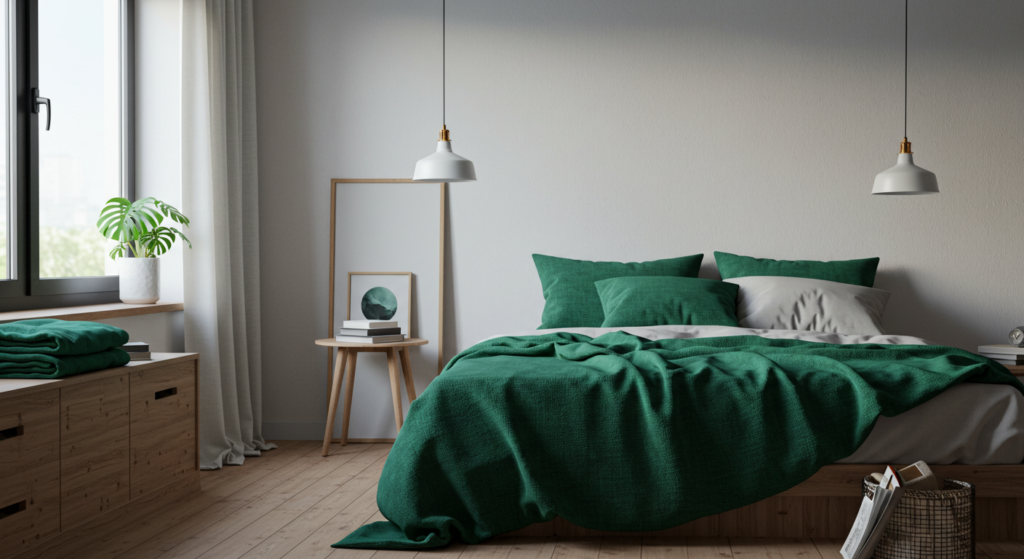
Everyday Style
Emerald can elevate a plain outfit. A single accent piece, like an Emerald hat or sweater, can bring a sense of harmony. This works well with a casual look or a more polished ensemble. People often choose an Emerald scarf to brighten a neutral jacket, adding a dash of personality without looking flashy.
Footwear in Emerald might seem daring, but it can make a statement at social events. A pair of Emerald shoes can turn heads while keeping an overall outfit balanced. The key is to pair Emerald items with simpler tones, such as whites, greys, or soft browns, so the color remains the star of the show.
Home Décor Choices
Emerald offers a versatile option for those who want a bit of color in their living areas. An Emerald couch could become a conversation starter. If that seems too strong, smaller items like rugs, throw pillows, or blankets in Emerald can bring a fresh layer of comfort. These additions work in living rooms, bedrooms, and sometimes even kitchens.
When using Emerald in home décor, consider how the color interacts with natural light. Large windows can bring out the warmth, while dim lighting can make the tone look deeper and more intimate. Mixing Emerald with metallic finishes like copper or brass often results in a sophisticated yet welcoming look.
Office Environments
Emerald might brighten a workspace without overwhelming it. An accent wall in a conference room can set a calm mood. Emerald chairs or desk accessories can add pops of color that stimulate creativity. In open-plan offices, small touches of Emerald can break up monotony, boosting morale.
The shade can also aid focus. Some employees might feel more relaxed with a bit of greenery, whether live plants or décor. This idea ties back to the psychological effects of color. If the work environment allows personal items, an Emerald notebook or pen holder can signal a sense of steadiness. It might also encourage a more thoughtful pace amid daily tasks.
Color Trends and Forecasts

Seasonal Shifts
Fashion and interior design trends often change with the seasons. Emerald fits well in spring and summer lines, where it can symbolize rebirth and fresh energy. Yet, this hue also finds a home in winter collections, matching deeper palettes that feature jewel tones. This flexibility keeps Emerald relevant through different times of the year.
People might lean toward lighter or brighter greens in warmer months, but they often welcome Emerald’s richness when temperatures drop. The color can pair with cozy knits or velvet for a holiday-friendly look. In design, Emerald can add a pop of color during colder seasons, suggesting the hint of life that remains green year-round.
Influences from Pop Culture
Music, cinema, and television frequently influence color trends. If a famous performer or character wears Emerald, fans might flock to replicate that style. Interior designers can see a jump in requests for Emerald furniture after a popular home-design show features it.
Social media platforms speed up these trends. A striking photo with an Emerald accent can spark thousands of shares. This color’s bold yet soothing vibe often translates well in images. As a result, Emerald sometimes appears in product lines for a season or two, though its classic appeal often helps it remain popular beyond short-lived fads.
Timeless Classics
Emerald is more than just a passing fad. Its status as a jewel tone gives it a natural edge in fashion and design. Jewel tones rarely go out of style because they suggest depth and quality. Emerald’s presence in historical artworks and architectural details also cements its role as a timeless color.
Individuals who crave something that lasts may choose Emerald for large furniture pieces, confident that it will keep its charm as trends shift. Jewel tones often reappear in style guides every few years. Emerald is a consistent favorite among them, providing a dependable anchor in a sea of changing color fads.
Design Color Meanings

Graphic Design Nuances
Graphic designers often analyze how color affects user engagement. Emerald can pull attention to key elements on a webpage or app without appearing harsh. It helps create a sense of calm while guiding the eye. When used in icons or buttons, Emerald stands out against lighter backgrounds, prompting users to click.
Print materials also benefit from an Emerald accent. A brochure for a wellness retreat might feature an Emerald band to add visual structure. This color can highlight a call-to-action or a headline. It gently signals the importance of the content without shouting.
Color Hierarchies
In design, a color hierarchy lays out which shades get the most attention and which serve as supporting tones. Emerald, with its noticeable but not overbearing presence, can easily become the main color or a secondary accent. If it serves as the main hue, then pale neutrals or gentle pastels can provide contrast.
When used as a secondary color, Emerald might appear in headings, bullet points, or icons. That way, the design remains clean and the eyes can navigate quickly. Regardless of the approach, color hierarchies that include Emerald often feel well-grounded. This aligns with the broader color theory viewpoint of green as a stabilizing force.
Collaboration with Other Colors
Emerald teams up with a wide variety of shades. It looks chic next to gold or silver, which is a common choice in packaging for luxury goods. It can complement earthy tones like caramel or mocha. This creates a cozy vibe that people often embrace in artisanal product lines.
When placed with other jewel tones like sapphire or amethyst, Emerald holds its own. Together, these colors create a dramatic palette. In minimalistic designs, a single pop of Emerald can awaken an otherwise monochrome scheme. This flexibility means many industries—from tech to fashion—can adapt Emerald to their visual language.
Interpreting Emerald through Art
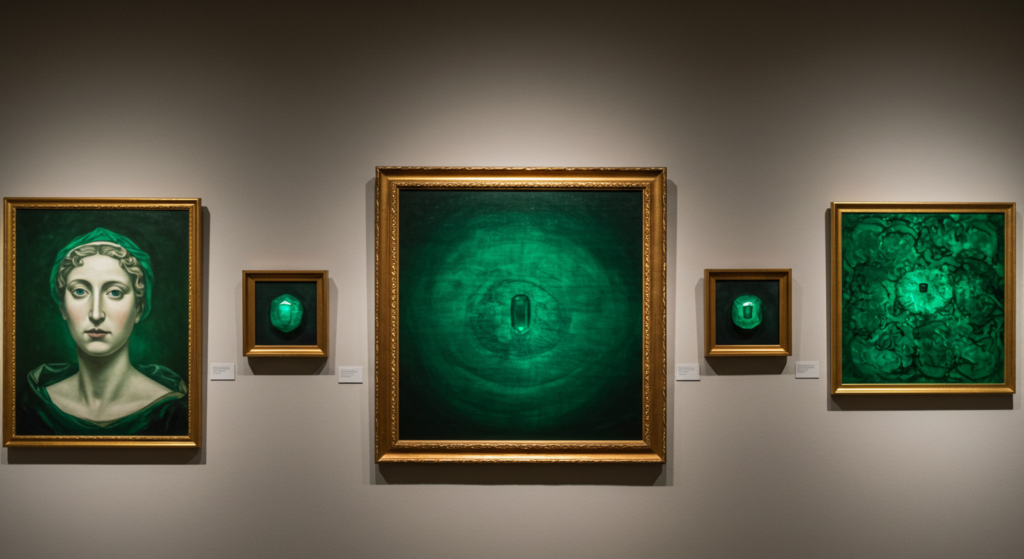
Symbolic Brushstrokes
Artists harness color to stir feelings, and Emerald is no exception. A painter might use it to convey life in a spring setting. Another might choose it for a background that suggests mystery. Emerald brushstrokes can also focus on small details, like the glimmer of a leaf or the centerpiece of a still-life arrangement.
Because this hue stands out, it can be used sparingly to create focal points. Art lovers often comment on how a small patch of Emerald can bring a painting to life. This color can make a subject appear fresh or full of new possibility. It may also draw viewers’ eyes toward hidden meanings in the piece.
Emotional Narratives
Color storytelling is an art technique where the chosen hues form a narrative. Emerald can show quiet renewal or passionate growth. It depends on context, lighting, and the surrounding elements. In a piece full of warm tones, one bit of Emerald might symbolize hope amid chaos. In a cool, blue palette, Emerald can act as a link to the natural environment or an anchor of stability.
These narratives resonate with audiences who view art as a gateway to deeper thought. Emerald’s connotations with wisdom, calmness, and optimism make it suitable for scenes that show healing or progress. Some sculptors or mixed-media artists add Emerald-hued glass or resin to capture these emotional layers.
Shifting Perspectives
Over time, the meaning behind a color can shift as cultural and personal viewpoints change. Artists might revisit Emerald to explore modern topics like sustainability or urban growth. They can question old beliefs about green and propose new ones. Viewers might see something unexpected in a modern painting that features Emerald, which keeps this color fresh.
In some galleries, classic and contemporary pieces hang side by side, each featuring Emerald in different ways. One might show a regal scene with ancient symbols, while another might highlight an abstract vision of new technology. This shifting perspective underlines how Emerald stays relevant across eras.
Conclusion

Emerald has a special magnetism that bridges ancient traditions and modern design. It embodies a mix of confidence, calmness, sincerity, and freshness. From cultural rituals to color branding, it remains a sought-after shade. People see it as a symbol of renewed energy, steady growth, or a sophisticated statement color.
Today, Emerald appears in clothes, interiors, packaging, and digital media. It meshes well with other bold hues or neutrals, and it works for different moods. The color’s meaning can be universal or deeply personal, depending on how it is used. Its well-rounded nature lets it slip into many niches, from a bold accent in a minimalist space to a mainstay of a brand’s identity.
Those who want to embrace Emerald will find practical tips all around. They can add a small Emerald accessory to their outfit, or they can paint a single accent wall to infuse a room with fresh energy. Designers might choose this shade to draw audiences in, offering a sense of trust or calm. As you explore Emerald’s qualities, you may discover new ways it can shape mood, spark creativity, or offer a comforting sense of balance.
Summary Table for Quick Reference

| Aspect | Description |
|---|---|
| Personality Traits | Blend of freshness, calmness, sophistication, and depth |
| Emotional Impact | Encourages relaxation, focus, and gentle energy |
| Cultural Color Meanings | Linked with growth, renewal, and abundance in many traditions |
| Design Color Meanings | Adds refined vibrancy to interior décor, branding, and graphics |
| Color Psychology Effects | Balances mental clarity and creative spark |
| Complementary Shades | Reds, pinks, corals, plums, neutrals like beige or cream |
| Use in Branding | Conveys trust, nature focus, authenticity |
| Popular Pairings | Gold, silver, soft browns, other jewel tones like sapphire and amethyst |
| Psychological Color Analysis | Possible link to reduced stress and calm focus |
| Historical Roots | Prized by ancient royals; believed to bring luck or symbolize wisdom |
| Seasonal Adaptability | Works in spring, summer, and winter as a classic and flexible hue |
| Versatility | Suits fashion, home décor, marketing, and artwork alike |
FAQ

Q1: Is Emerald the same as other green tones?
Emerald differs from lighter or darker greens. It has more depth than mint and is brighter than forest green. Its warm undertones set it apart, giving it a balanced, vibrant feel.
Q2: How can I incorporate Emerald into my home without going overboard?
Try small items first, like pillows or artwork. An Emerald accent wall can work if the rest of the room remains neutral. Metallic finishes also pair well, so you can add gold or bronze lamps and frames.
Q3: Does Emerald have any special cultural symbolism I should know about?
In many places, green represents luck, renewal, or fertility. Emerald often shows up in ceremonies or celebrations. Ancient communities sometimes linked Emerald to wisdom and spiritual protection.
Q4: What makes Emerald appealing for brand logos?
Emerald can signal growth, harmony, and originality. It stands out from standard blues and reds and projects a sense of trust or environmental awareness, making it great for brands that value sustainability.
Q5: Can Emerald really calm the mind or aid focus?
Some color psychology studies suggest green shades may help reduce stress. Emerald’s deeper hue offers a peaceful vibe that might boost clarity. Individual responses vary, but many people find it soothing.
Q6: Do I need to worry about seasonal color trends when using Emerald?
Emerald works across different seasons, thanks to its versatility. It can feel fresh in spring and summer, yet its jewel tone quality fits with richer palettes in fall and winter. It’s a safe choice year-round.
Q7: Can I mix Emerald with bold colors like red or pink without causing a clash?
Yes. Red is actually the complementary color to green. When handled carefully, an Emerald-and-pink mix can look playful and appealing. Be sure to balance them with neutrals or soft textures to avoid clashing.
Q8: Is it important to consider lighting when using Emerald in décor?
Lighting can shift how Emerald appears. Natural light can reveal its warmer undertones. Fluorescent lighting might make it look cooler. Test small samples or swatches in different lighting to see if it meets your needs.
Q9: Why is Emerald often linked to nature’s color meanings?
Emerald shows up in lush plants, tropical sceneries, and even certain bird feathers. These natural associations help people connect it to themes of life, growth, and renewal.
Q10: Can Emerald help my office environment feel less sterile?
A splash of Emerald in office décor can break up monotony and might improve morale. It can also add a calm energy, promoting a comfortable and engaging space for employees or visitors.
Q11: Are there any scientific studies about Emerald in particular?
Most research focuses on green in general. Studies suggest that mid-range greens may reduce eye strain and foster relaxation. Emerald, as a deeper green, can bring these benefits with a more intense impact.
Q12: Does Emerald require careful thought when pairing it with patterns or prints?
Yes, because it’s a strong color. If paired with busy prints, Emerald may compete or overshadow them. Keep the patterns subtle, or use Emerald for a simpler piece that complements the print’s main hues.
Q13: Can I use Emerald for a child’s room without making it too serious?
Yes. Pair it with brighter accents like yellow or soft pink. That can lighten the mood and make the room feel cheerful. Consider using playful patterns with small doses of Emerald for a fun twist.
Q14: How do I avoid a dull look if I choose Emerald furniture?
Combine different textures, such as velvet or linen, and add metallic or wooden elements. This approach introduces variety, preventing a flat appearance. Emerald seating with throw pillows in lighter colors can also keep things lively.

Anna West, the visionary behind Clothes Color Guide, is our go-to for all things fashion. Merging the finest of runway trends with everyday style, she demystifies the world of color and pattern. While clothing is her mainstay, Anna also shares insights on interior design, pet care, and relationship advice. Dive into her articles and emerge with a vibrant perspective on style and life.
Reviewed By: Joanna Perez and Marcella Raskin
Edited By: Lenny Terra
Fact Checked By: Sam Goldman
Photos Taken or Curated By: Matthew Mansour
